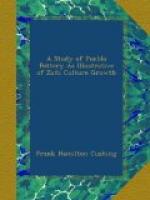[Illustration: FIG. 525.—Ancient bowl of corrugated ware.]
The water jar, like the food-bowl, is a conspicuous household article; for which reason the Zuni woman expends all her ability to render them handsome. Judging by this, the desire to decorate the water-vessel with paint, like its constant companion the food-bowl, would early lead to the attempt to make its surface smooth. This would need to be effected while the article was still soft; which necessity probably led to the discovery that ajar of the corrugated or simply coiled type may be smoothed while still plastic without danger of distortion, no matter what its size, if supported at the bottom in a basket or other mold so that it may be shifted or turned about without direct handling. (See Fig. 526.)
[Illustration: FIG. 526.—Basket-bowl as base-mold for large vessels.]
[Illustration: FIG. 527.—Clay nucleus for a vessel.]
[Illustration: FIG. 528.—Clay nucleus
shaped to form the base of a
vessel.]
After this discovery was made, the molding of large vessels was no longer accomplished by the spiral method exclusively. A lump of clay, hollowed out (see Fig. 527), was shaped how rudely so ever on the bottom of the basket or in the hand (see Fig. 528), then placed inside of a hemispherical basket-bowl and stroked until pressed outward to conform with the shape, and to project a little above the edges of its temporary mold, whence it was built up spirally (see Fig. 529) until the desired form had been attained, after which it was smoothed by scraping (see Fig. 530).
[Illustration: FIG. 529.—Clay nucleus
in base-mold, with beginning
of
spiral building.]
[Illustration: FIG. 530.—First form of vessel.]




